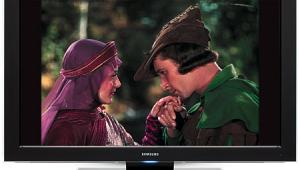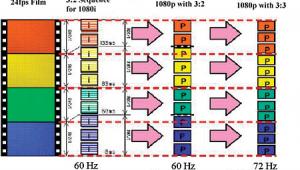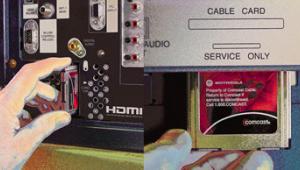Tech Trends 2013: Video
In this four-part article, Geoff Morrison examines the future of Ultra HD and OLED TV (below); Al Griffin looks at the latest developments in Smart TV; Geoff gives us an update on what's happening with plasma TV; and Al finishes with a discussion of the devices and technologies that will deliver 4K Ultra HD content to homes.
Ultra HD and OLED get real
High-res, high-tech TV coming this year
There is no question that the star of CES 2013 was Ultra HD, the resolution formally known as "4K." In its high-rez shadow was Organic Light-Emitting Diode, a technology that has been lurking at the dreamy edges of our desires for years. Without question, these are our next-generation TVs. Fortunately, an Ultra HD OLED is already possible, so they're not mutually exclusive. They are not, however, equally beneficial.
HDTV Quadrupled
First, the "what." Ultra HD provides at least four times the resolution of 1080p. This means 3,840 x 2,160 pixels to your current TV's 1,920 x 1,080 pixels. The first Ultra HD TV to ship was an 84-inch LG model in late 2012, followed by a Sony that shared the same size, specs, passive 3D capability - everything but the same model number. Priced at $20,000 and up, these TVs are not for the light of wallet. (However, the recent introduction of a stripped-down, 50-inch 4K TV from Seiki Digital suggests 4K prices may come down fast.)
On paper, 4K is an awesome improvement: Higher resolution means you can get a larger screen without seeing pixels, and you can sit much closer for the same reason. I'm willing to bet you sit about 9 feet from your TV, so if you're planning on buying a 50- or 60-inch TV, Ultra HD has more resolution than your eye can process at that distance, so you'd need to sit as close as 5 to 6 feet away to derive any benefit.
If you really want Ultra HD, though, know that by the time you can afford it, there is likely to be content available. There was no 1080p content for years after 1080p TVs arrived, and the situation is likely to be the same with Ultra HD. It's a common misconception that 1080p HD is somehow a "maximum" resolution. True, if a TV show or movie is shot at 1080p, that's the most you're ever going to get. Many movies (past and present) are shot on film, a medium with much higher resolution potential. Some new movies are shot on 4K video. Movie studios are already transferring older films to 4K. How we'll get these 4K movies into the home, though, remains up in the air. Sony has announced a download service, while Netflix has demo'd 4K streaming. (See sidebar "What's on Ultra TV?" on page 4 for more info.) Will we see 100-GB Blu-ray discs with 4K video? Who knows? We'll certainly hear more about these and other offerings in the coming year(s).
A bigger issue is that the new Ultra HD TVs only adhere to the current standard for HDTV video. For that matter, an HDMI 1.4 connection can only handle Ultra HD resolution up to 24 frames per second (fps), which precludes 4K 3D as well as higher frame rates (like 4K video games or content shot at 30 or 60 fps). This limitation will likely be solved by the HDMI 2.0 spec that's due out this year, but it's unclear if any of the shipping/pending Ultra HD TVs can be upgraded to work with 2.0. This won't be a firmware change; it will have to be a hardware change.
OLED Allure
OLED, on the other hand, is an entirely new television technology, slotting in above both plasma and LCD in terms of picture quality. In an OLED display, current flows to an organic (i.e., containing carbon) material that glows a certain wavelength. Thanks to decades of research, materials have been found that glow the exact wavelengths needed to create a TV picture: red, green, and blue. You can turn off the current to create a pixel that's actually, absolutely, black, and do so on a pixel-by-pixel basis. You can't do this at all with LCD, and even with plasma, the pixel still glows slightly when it's supposed to be black. What this means for OLED is a truly infinite contrast ratio, for the best image you've ever seen on a TV. It also means that TVs can be thinner (a few millimeters) and draw even less current than an LED-backlit LCD (reputedly less power than a light bulb requires).
However, as with any new technology, there have been issues to overcome. The biggest was figuring out how to manufacture large OLED screens cheaply enough that anyone could buy them. They're heading toward that point. LG's 55EM9700 should be shipping by the time you read this for the low, low price of … $12,000. This is also known as a "Nissan Versa 1.6" or "House Down Payment." Those with long memories will recall that this is actually cheaper than the first plasma HDTVs, which were both smaller and a huge step backward in picture quality compared with the CRTs and RPTVs of the era. OLED is at least a leap forward in picture quality, and as they make more of them, they'll figure out how to make them cheap enough that we hoi polloi can afford them.
The Goods
LG displayed its second-gen 55EA8800 model at CES, but it wasn't the only company showing off OLED. Samsung showed its F9500, a 55-inch set that uses red, green, and blue OLEDs. (This contrasts with LG's method of using a white OLED "sandwich" with red, green, blue, and white filters.) We'll be interested to see if there are any performance differences between the two methods when Samsung's OLED eventually ships. Even more interesting, the F9500 has a Multi-View feature that allows two 1080p programs to run onscreen at the same time. Specific active-shutter glasses (like you'd use for 3D) filter the images so that you only see your chosen program, and they also have built-in headphones so that you can also filter the sound. LG has a version of this in some of its LCD TVs, but because those are based on passive 3D technology, resolution is only 1,920 x 540 for each viewer.
Sony and Panasonic, less than a year off their deal to co-develop OLED TVs, each showed 56-inch Ultra HD OLEDs. These were certainly pretty, though they were roped off at a distance that precluded up-close-and-personal nose-to-screen scrutiny.
Except for that one Sony/Panasonic presumed sibling, all the other Ultra HD displays were LCDs. We can assume, then, that they will have all the strengths of LCD, like light output and relatively low energy consumption, along with its weaknesses, like poor native contrast ratio, poor off-axis viewing angle, motion blur, and the rest. So while increasing resolution is cool, it is not the only picture-quality factor.
The myriad models on the floor at CES ranged from 110-inchers from Westinghouse and Hisense to 50-inch models from the same companies, with multiple sizes in between. Sharp talked about a 60-inch due out this summer that features "Integrated Cognitive Creation" technology, using upconversion and other video processing to make the image more realistic. Not content with 4K, it showed an 85-inch 8K LCD at their booth. Sharp is one of the leading developers of IGZO, or Indium Gallium Zinc Oxide, a new material for the thin-film transistors in all LCD TVs. One of IGZO's main benefits is that it allows smaller pixels, potentially making the higher resolutions of 4K and 8K easier to manufacture.
Toshiba discussed 58-, 65-, and 84-inch models, all containing a beefy-sounding CEVO 4K Hex Core Processor. Processing is an important aspect, as upconverting 1080p to 2160p is not easy.
Sony, having already released an 84-inch Ultra HD, announced 55- and 65-inch models. The X900A series also features "Triluminos" backlighting, which is a traditional LED backlight with quantum dots creating red and green light. (The LED itself creates the blue.) Potentially, this could mean more realistic color compared with a regular LED LCD. This new technology will also be found in the high-end-but-1080p-rez W900A series. All should be available by the time you read this.
Then there was Samsung's UN85S9, an 85-inch Ultra HD with a unique easel-looking stand. The TV's speakers are built into the stand, and even though Samsung claims the big TV is wall-mountable, the easel isn't detachable. (It folds "flat" around the TV.) Samsung says the 85S9 will come out this year.
So while Ultra HD is going to get the lion's share of marketing hype, OLED is the tech to keep an eye on. Ultra HD will make some content look a little better if you're sitting close to the TV or if the TV itself is massive. OLED will make all content look better. And that wall-size TV you've always dreamed of? It's going to happen, it will probably be a 4K OLED, and it's not too far off.
The future of TV tech is finally looking exciting again. -Geoff Morrison


























































